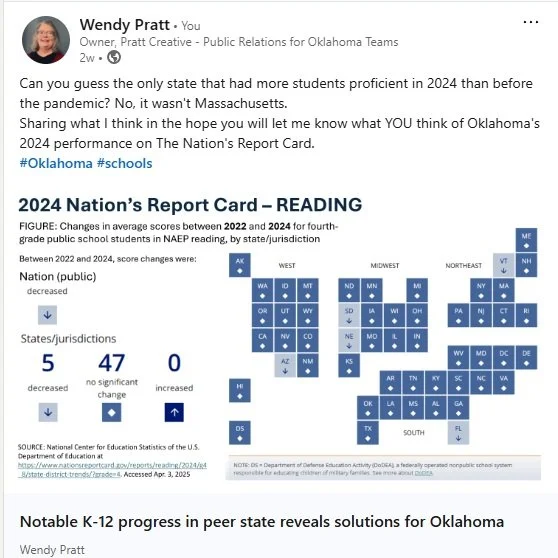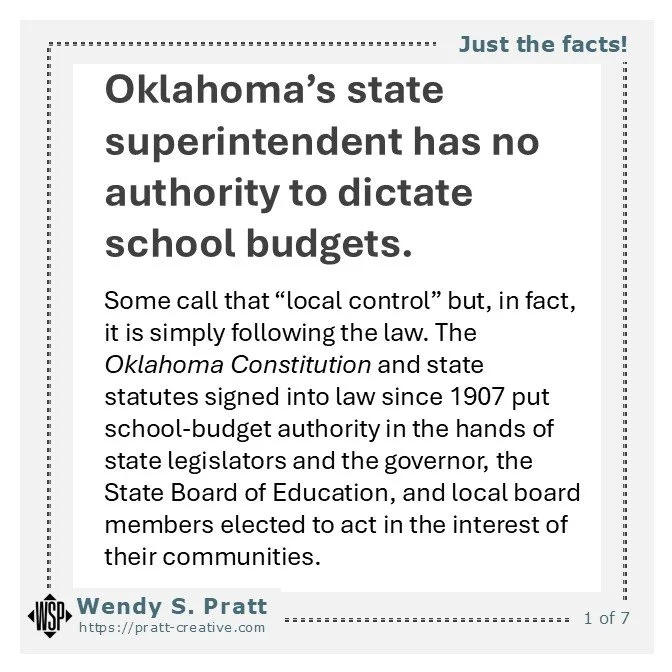by Wendy S. Pratt, July 31, 2025
It is odd being 50th in education again when such rankings are so often just clickbait. Few groups ranked states when Governor Bellmon signed the Education Reform and Funding Act of 1990 (House Bill 1017) into law. In those days, Oklahoma students were scoring at about the national average on standardized state tests, our high-school graduation rate ranked 36th, and our ACT average composite was just 0.6 points below the average of all states and the District of Columbia. Yet, in 2024, Oklahoma’s ACT average ranked second-to-last nationally.
That’s not even the worst of the worsening. Consistent measures of college attendance by the Oklahoma State Regents for Higher Education does not extend (online) to 1990; but, in Fall 2010, more than half of high school graduates went on to higher education. From the Class of 2023, barely one-third enrolled in college that fall. There were 11.5% more high school graduates in 2023 than in 2010, but 27.4% fewer of them went directly to an Oklahoma college. This is a serious problem.
What does “50th in education” mean to Oklahoma?
Oklahoma's ranking of 50th among 51 states and DC on WalletHub's 2025 national report is a sad picture but important to see. It is mainly about two factors: insufficient investment and low scores on national tests.
The most shocking of the achievement factors is Median ACT Score. By 2010, Oklahoma had improved its ACT average to just 0.3 points below the national average; but last year Oklahoma’s average was 1.8 points below. [Yes, these are two of only nine states that assessed all their 11th grade students on the 2024 ACT. Therefore, national comparison to states assessing low percentages is not valid. But among these nine states, only Nevada scored lower, and that’s apples all round.]
WalletHub’s analysis IS more comprehensive than most and "accounts for performance, funding, safety, class size and instructor credentials … across 32 key metrics." ... WalletHub categorized Oklahoma as a “Low Spending & Weak School System.” From the report’s author, WalletHub Analyst Chip Lupo:
“Getting enough funding is essential for a productive school system, but
simply having more money doesn’t guarantee success. How funds are
applied also plays a big role in how good a school system is, as does the
quality of educators, other professionals and the curriculum. In addition,
schools need to focus not just on test scores but also on making sure that
students feel safe, comfortable and cared for.”
Oklahoma parents and educators have been articulate on this issue in multiple news reports. Unfortunately, the worst thing we can do is tell students Oklahoma is last in education. But if the adults would talk about it, possibly more elected federal, state and civic leaders would work together to lift us out of this hole. It’s critical that we stop digging because why should students try if they assume their teacher, their class, their school and their state is the worst in the country? And while such labels tend to indict ALL, it is simply NOT TRUE that our schools are substantively worse than those in other states.
All rankings are based on averages and (usually) apply weights to many factors over which students, teachers and schools have no control. The actual WalletHub findings are enlightening because, of course, it is not all bad news! WalletHub’s summary of the top and bottom state rankings by category is an eye-opener for sure. There you’d see that Oklahoma is NOT in the bottom five states in Dropout Rate, Math Test Scores, Median SAT Score, Pupil-Teacher Ratio, Percent of Threatened/Injured High School Students (which Texas, Kansas and Louisiana are) nor Bullying Incidence Rate. This ought to count for something. What we are struggling with is the weight of chaos and grandstanding.
Teaching and learning in Oklahoma continue – no matter funding freezes or changes in law or policy or bureaucrats or voter support. “Back to school” is happening now and school-house doors will open within two weeks. So, it’s one thing to be a political joke but it is another to keep making things worse. The state superintendent’s whack-a-mole strategy to distract from his failures and toward his political ambitions diverts everyone’s eyes from improving Oklahoma’s educational outcomes. And THAT is NOT fair to the 700,000 children in our public schools now nor the ones to come. It stifles Oklahoma’s economic development and is, in fact, making the state’s devastating teacher shortage worse.
If the current state superintendent had ever worked to build consensus toward a strategic plan – like previous state superintendents have – that would be something. But many were surprised when, amid all this hullabaloo, Ryan Walters presented to the Internet on July 8 his first (as best I can tell) comprehensive plan of action as an elected leader. The timing of his proposed amendments to Oklahoma’s “Consolidated State Plan” was likely prompted by a deadline in Senate Bill 711 (thank goodness). But the amendments presented here https://oklahoma.gov/education/essa-amendment.html are not just changing “equitably” to “fairly” and “equitable” to “effective” and “equity” to “fairness” and removing Chronic Absenteeism from the state accountability formula.
The bottom line is that in 1990 we were told standards-based education reform would improve all schools; it did not. We thought, at some point, Oklahoma would invest enough in education to make a difference in the results; it did not. Once upon a time, I believed Oklahoma needed more school choice but all we have gotten is more of the same choices: no innovation, no forward-thinking, no collaboration. It makes no sense that our leaders have not prioritized funding a basic education for every child in the 35 years since HB1017 began implementation. The Oklahoma Constitution is clear in Section XIII-1: “The Legislature shall establish and maintain a system of free public schools wherein all the children of the State may be educated.”
All things considered today, Oklahoma public schools are over-mandated and under-funded to the point that parents and teachers are picking up more and more of the costs. Apparently, that is what 50th in education means to Oklahoma.

1: Okla. Student Performance 2024

2: NAEP Analysis

3: Oklahoma School Designations

4: Publishing (writing, editing, prepress)

5: Article on 2024 State-Test Cut Scores Change

6. Quotes and fun stuff!

7. Oklahoma City's Dr. Jamie Polk - greatness and grace at InspireOK 2025




